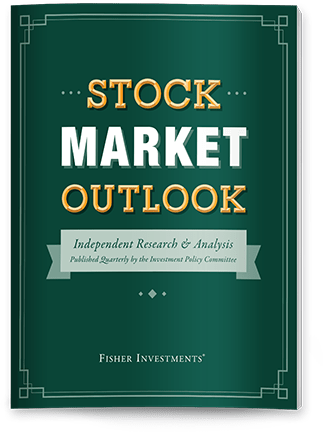Personal Wealth Management / Economics
Global Manufacturing Green Shoots?
The latest PMI readings reveal ongoing services-led global growth—and hint at manufacturing recovery.
As August winds down, we have our first economic temperature check for the month. Yes, flash global purchasing managers’ indexes (PMIs) are out! These preliminary surveys, which reveal the breadth of firms’ growth (but not its magnitude), suggest ongoing, services-led expansion in the world’s developed market economies. Meanwhile, although manufacturing PMIs remain mostly contractionary, we see hopeful nuggets in the long-beleaguered sector. We think this is notable since it occurred even as tariffs took effect this month, perhaps implying the world is starting to move forward. Regardless, the bigger picture of overall global growth stands, undercutting economic fears and showing in part what stocks have been pricing in.
Exhibit 1 shows the bulk of developed market economies’ business activity expanding, as services continue to do the heavy lifting. Composite PMI readings combine services and manufacturing output, with readings above 50 indicating a majority of private sector firms surveyed see growth. Since services make up more than two-thirds of most developed market GDPs, if over half those firms are experiencing expansion, then that is generally a good sign. With all save France’s composite PMIs above 50 through August, broadly matching services’ direction, the global economy remains on growthy footing.
Exhibit 1: As Go Services, So Go Composite PMIs Generally
Source: FactSet, as of 8/21/2025. Note: August’s PMI readings are “flash” estimates based on preliminary calculations from around 80% to 90% of total responses.
But even France is just a couple hairs short of the mark. And French GDP grew through Q2 despite sub-50 composite readings. Since PMIs reveal only the percentage of firms reporting growth—not how much activity rose or fell—an expansionary minority can still outweigh those contracting. This is why it is difficult to draw big conclusions when PMIs are just below or over 50.
Also noteworthy: UK services PMI’s bump higher. While a 1.8 point rise further into expansionary territory isn’t necessarily eye-popping, the improvement is striking amid constant warnings of April’s employer tax hikes crushing services especially hard. The vast majority of the British economy appears to be clawing forward. We think this underscores the yawning gap between reality and sentiment across the pond—the wall of worry abroad remains high.
While services are still the main engine driving developed market economic growth, we see some encouraging signs manufacturing is starting to perk up. Besides expansionary manufacturing PMIs in America and the aggregate eurozone, Japan’s, Germany’s and France’s are just a hair under 50—on the cusp of growth.
This is all early days, of course, and nascent stabilization isn’t rip-roaring growth. But the backdrop here is worth considering, as it shows how reality may beat expectations. Early 2025’s tariff talk seemed to cause two things in the short term: uncertainty and stockpiling as businesses raced to beat extra charges. Perhaps the uncertainty is now beginning to fade as trade deals conclude, firms know the lay of the land better and, seeing more stability, manufacturers feel more confident about their prospects. Not only do the data appear to indicate the increasing likelihood of manufacturing green shoots, so do markets with Industrials outperforming global stocks year to date.[i]
Markets move first. As timely as PMI data are, all this is mostly in the rearview for stocks, which look roughly 3 to 30 months ahead. However, we can peer somewhat into the future and take a few cues from PMIs’ new orders—a leading indicator, as today’s bookings are tomorrow’s production and billings. And new orders are faring broadly fine, rising across most of the developed world’s services sectors, though they are more mixed in manufacturing. Here is how S&P Global describes America’s outlook: “new order inflows in the goods-producing sector also picked up in August, with growth hitting the highest since February 2024 principally on the back of rising domestic demand but also helped by the largest rise in goods exports for 15 months.”[ii]
Now, some of this may be an after-effect of early-year inventory builds, with firms needing to replenish after running down pre-tariff stockpiles. “While many manufacturers reported improved sales and demand, the upturn in production and order inflows was in part linked to renewed inventory building. Stocks of finished goods rose to an extent not previously recorded since data were first available in 2007 ...”[iii] Whether this is good or bad depends on sales’ holding up, but it does suggest the wheels are starting to turn again after tariff uncertainty threw some sand in the gears. Moreover, most countries didn’t enact retaliatory tariffs against the US, enabling them to return mostly to business as usual with US suppliers.
Meanwhile, although manufacturing orders in the UK and Japan were weak, eurozone manufacturing new orders expanded even though businesses there now face a 15% US tariff, perhaps a sign that just knowing the lay of the land is helping businesses move forward.[iv] Manufacturing may not be firing on all cylinders, but that is well known, and nascent glimmerings point to a potentially better-than-appreciated reality than most think.
So stay tuned for more of the same: overall global growth led by services. While the jury is still out on manufacturing, stocks clearly haven’t missed it. Scale and perspective are key, of course. Given its small role in developed-world economies, manufacturing’s woes weren’t a massive headwind. Any tailwinds are probably slight at a macroeconomic level. But for stocks, it is all about sentiment versus reality. If a sector that gets outsized attention and is a chronic source of angst beats meager expectations, that is generally good enough.
If you would like to contact the editors responsible for this article, please message MarketMinder directly.
*The content contained in this article represents only the opinions and viewpoints of the Fisher Investments editorial staff.
Get a weekly roundup of our market insights
Sign up for our weekly e-mail newsletter.

You Imagine Your Future. We Help You Get There.
Are you ready to start your journey to a better financial future?

Where Might the Market Go Next?
Confidently tackle the market’s ups and downs with independent research and analysis that tells you where we think stocks are headed—and why.






